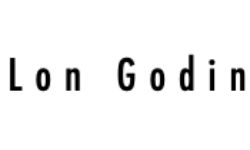Lon Godin’s paintings are often large and have an immediate impact without being narrative. Movement, patterns, light are the elements by which her large canvases impress.
The paintings evoke associations with architecture or nature.
In all of her painting the sense of movement stands out. Color areas sometimes appear out of focus, like a blurred photo, structures pulsate in space, draw you in as a viewer or take you at great speed across the surface of the canvas.
All of this can also be found in her video installations and photos. But that’s obvious. Light is the brush of photography. In the same way she uses light in her abstract paintings.
As a viewer you are initially captured by the power and dynamic beauty of the image. Gradually you enter her world of painting, you recognize the rules, the qualities of the brushstroke, the rhythm of the form and the necessity of the structure.
In this way the work gains meaning and it continues to speak to you.
Insight into her method and awareness of the importance of her choices during painting itself are important for understanding her work. What seems obvious is the result of a very disciplined and highly skilled exploration of painting.
Lon Godin has been creating abstract art throughout her career. Photos, film and especially paintings. It seems an obligatory statement, but it is essential: abstract art is not the same as non-objective art. Lon Godin makes abstract work.
She starts from structure and color. In doing so, she consciously works in a now long and rich tradition of artists who create abstract art, from Malevich and De Stijl to Gerhard Richter and Gunther Forg.
In addition to color, light, form and structure are the important actors on the canvas.
Lon Godin builds up her paintings very carefully; constructs the forms and gives effect to the execution as if the logic of the painting itself dictated her hand. First, there is a series of actions that create a structure.
The painting fills itself with the action and the materiality of the brushstrokes. There is no preliminary image or a concept.
She starts from a painterly credo, in which the structure and the painting itself, together with the self-imposed limitations, will ultimately determine the image.
In the seemingly small field of abstract art, every detail and every gesture matters. The thickness of the paint, the reference to the shape of a structure, the end of the paint stroke, the slightest intervention can create associations with work by famous predecessors. Mark Rothko, Gerhard Richter, Per Kirkeby, or Sean Scully, her work fits into a painterly tradition that knows these artists as dominant beacons.
Movement, space and emotional charge are the result of a strictly personal search for the exspressiveness of art.
For Lon, color in itself is nothing. Color is part of the outcome of painting. For her, in first instance in the painting, but also in her photos and videos, it is about space that is created by light, movement and color.
She has been very strict for a long time, she says. She concentrated on systematics, the quality of the paint stroke, space, materiality and dynamics.
Part of her fascination at this point is how much of that rigor can be let go without the image acting randomly.
How to find a parallel between experiences in ‘reality’ and experiencing the painting.
2019 Jeroen Chabot
